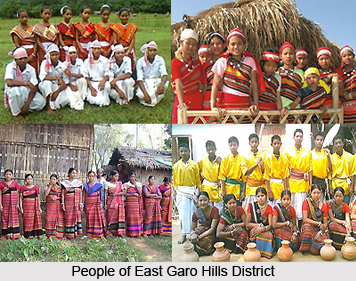People of East Garo Hills District are mainly the Garo Tribes and when it comes to the people the social life, the language and other features are taken into account. Garos constitute the majority in the East Garo Hills district as is evident from the name of the district. The district also is home for a sizeable population of Rabha Tribes, Hajong Tribes, Koch Tribes, Dalus, Banais and Boros.
As history exemplifies the Garos are the second largest tribe after the Khasis in Meghalaya and they refer themselves as A`chik or Mande and their language converged to the Bodo language branch of the Bodo-Naga-Kachin family of Sino Tibetan phylum. This Garo populace is basically distributed over the three Garo Hills districts of Meghalaya, the Mymensingh District of Bangladesh and the Kamrup, Goalpara and Karbi-Anglong districts of Assam. They can even be seen scattered in a few numbers in Tripura and Nagaland.
As the Garos are and were scattered far and wide since time immemorial and since these scattered units were in isolation from each other over the bridges of time it is obvious that they have developed their own separate identities and dialects. Even then features like their traditional political setup, social institutions, and marriage systems, inheritance of properties, religion and beliefs are frequent between these groups. Moreover, these groups are endogamous generally. The various dialect groups that comprises the Garos are the Ambeng, Atong, Akawe (or Awe), Duals, Matchi, Matabengs, Chibok, Chisak Megam or Lyngngam, Ruga, Gara-Ganching. However the most significant and striking difference is that between the groups who live closer to the plains and the hill dwellers that constitute the remaining groups. The Garos of the hills practice slash-and-burn agriculture or Jhum-cultivation while the Garo of the plains practice wet-rice agriculture and live in a cultural and ecological environment entirely different from that of the Garo of the hills.
 Society of East Garo Hills District
Society of East Garo Hills District
One interesting feature of the Garo society is that it is entirely a casteless society which even sets the democratic parameter of the clan. It is matrilineal and inheritance is through the mother. All children, as soon as they are born, belong to their mother`s Ma`Chong, whence Dalton`s Term "motherhood". Inheritance of property among the Garos is generally linked with matrimonial relations, and although men may have no property to pass on, they have an important say in deciding to whom it should pass. The heiress is generally, the youngest daughter or the "Nokna". If the Nokna is unmarried, as she often is, since selection generally takes place before she get married, the father will try to get a young man from his own lineage, commonly the son of his own sister, as the husband of the heiress. The nokna`s husband is called the "Nokrom".
Settlement of East Garo Hills District
The Garos live in semi-permanent villages varying in size from 10 to 60 houses. Village populations rarely exceed 300. There are five named, exogamous, matrilineal prairies called "Chatchi". Only two of these, Sangma and Marak, are found throughout. The other three viz. Momin, Shira and Arengh are not widely distributed. The Phratries are divided into many named, matrilineal sibs, each of which is restricted to a specific locality. The sibs are divided into unnamed lineages referred to as Mahari. Each village is built around one or two of these lineages, and most of the lineage women, with their husbands, live in the village, as do some of the men with their wives. One household is usually considered to be the most senior, and the other houses are thought to have branched out from it. This household holds all the village land, and the husband of the heiress is considered to be the headman of the village or the Nokma.
Economy of East Garo Hills District
Historically, the Garos were hardly land owners and whatever land they hold in possession, it is without ownership documents and the land belonged to the tribe as a collective property, cultivated under a cooperative system. Theoretically, land is owned by the Nokma, and new sections are distributed among the households each year. Among the hill Garos, all subsistence is based on Jhum Cultivation. Dry rice is the primary crop, and millet is also important. In addition, bananas, papaya, maize, manioc, taro, squash, large-pod beans, sorrel, gourds, and many other vegetables are grown to supplement the diet. Important cash crops are cotton, chilli peppers, and ginger. Wet rice has been grown more recently in some of the low areas, and this has changed the land tenure system to one of individual ownership, a situation which has had profound implications for the social structure.
Sports in East Garo Hills District
There are no organized games such among the Garos, though this does not imply that they have nothing to amuse themselves with. Games are generally played occasionally. Jumping contests and other competitions are indulged in more as tests of strength. The young males, members of the Nokpantes or Bachelor`s Dormitories, may organize themselves into groups and engage in such contests as the Wa`pong Sika, the Garo version of the tug-of-war, in which a stout bamboo pole replaces the rope and the contesting teams try to push each other beyond a marked line instead of pulling. Again, the villages may turn out in strength to take part in communal fishing.






